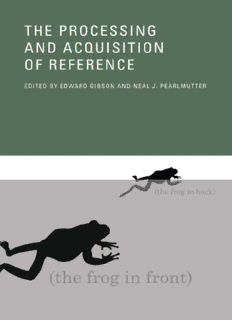Table Of ContentThe Processing and Acquisition of Reference
The Processing and Acquisition of Reference
edited by Edward Gibson and Neal J. Pearlmutter
A Bradford Book
The MIT Press
Cambridge, Massachusetts
London, England
© 2011 Massachusetts Institute of Technology
All rights reserved. No part of this book may be reproduced in any form by any elec-
tronic or mechanical means (including photocopying, recording, or information storage
and retrieval) without permission in writing from the publisher.
For information about quantity discounts, email [email protected].
Set in Times New Roman and Syntax on InDesign by Asco Typesetters, Hong Kong.
Printed and bound in the United States of America.
Library of Congress Cataloging-in-Publication Data
The processing and acquisition of reference / edited by Edward A. Gibson and Neal J.
Pearlmutter.
p. cm.
This volume presents papers from the special session at the CUNY Sentence
Processing conference that was hosted by MIT and Northeastern University in 2003.
Includes bibliographical references and index.
ISBN 978-0-262-01512-7 (alk. paper)
1. Reference (Linguistics) — Congresses. 2. Language acquisition — Congresses. I.
Gibson, Edward, 1962– II. Pearlmutter, Neal J., 1967–
P325.5.R44P76 2011
401'.456 — dc22 2010022680
10 9 8 7 6 5 4 3 2 1
Contents
1 Introduction 1
Edward Gibson and Neal J. Pearlmutter
I Children’s Acquisition and Processing of Reference
2 Cues Don’t Explain Learning: Maximal Trouble in the Determiner
System 15
Ken Wexler
3 Children’s Use of Context in Ambiguity Resolution 43
Luisa Meroni and Stephen Crain
4 Referential and Syntactic Processes: What Develops? 65
John C. Trueswell, Anna Papafragou, and Youngon Choi
5 Parsing, Grammar, and the Challenge of Raising Children at LF 109
Julien Musolino and Andrea Gualmini
6 A Cross-Linguistic Study on the Interpretation of Pronouns by Children
and Agrammatic Speakers: Evidence from Dutch, Spanish, and
Italian 133
Esther Ruigendijk, Sergio Baauw, Shalom Zuckerman, Nada Vasić,
Joke de Lange, and Sergey Avrutin
7 Processing or Pragmatics? Explaining the Coreference Delay 157
Tanya Reinhart
II Adults’ Processing of Reference: Evidence from the Visual-World Eye-
Tracking Paradigm
8 Disfluency Effects in Comprehension: How New Information Can
Become Accessible 197
Jennifer E. Arnold and Michael K. Tanenhaus
vi Contents
9 It’s Not What You Said, It’s How You Said It: How Modification
Conventions Influence On-Line Referential Processing 219
Jodi D. Edwards and Craig G. Chambers
10 The Effect of Speaker-Specific Information on Pragmatic Inferences 239
Daniel Grodner and Julie C. Sedivy
11 Referential Processing in Monologue and Dialogue with and without
Access to Real-World Referents 273
Simon Garrod
III Adults’ Processing of Reference: Evidence from Corpora and Reading
Experiments
12 Noun-Phrase Anaphor Resolution: Antecedent Focus, Semantic Overlap,
and the Informational Load Hypothesis 297
H. Wind Cowles and Alan Garnham
13 Investigating the Interpretation of Pronouns and Demonstratives in
Finnish: Going beyond Salience 323
Elsi Kaiser and John C. Trueswell
14 Not All Subjects Are Born Equal: A Look at Complex Sentence
Structure 355
Eleni Miltsakaki
15 Complement Focus and Reference Phenomena 381
Anthony J. Sanford and Linda M. Moxey
16 The Binding Problem for Language, and Its Consequences for the
Neurocognition of Comprehension 403
Peter Hagoort
Index 437
The Processing and Acquisition of Reference
1 Introduction
Edward Gibson and Neal J. Pearlmutter
This volume presents papers from a special session at the Sixteenth Annual
CUNY Conference on Human Sentence Processing, hosted by the Massachu-
setts Institute of Technology and Northeastern University in 2003. The goal of
the special session was to bring together researchers in the fields of language
processing and language acquisition to discuss topics of common interest: how
people refer to objects in the world, how people comprehend such referential
expressions, and how children acquire the abilities to refer and understand ref-
erence. Linguistic reference is particularly well suited to connecting the fields
of acquisition and processing because it is an active area of research in both
linguistics and psycholinguistics, because questions related to producing and
understanding reference are already under investigation in both adults and
children, and because it is particularly amenable to investigation using head-
mounted eye-tracking methods (Tanenhaus, Spivey-Knowlton, Eberhard, and
Sedivy 1995; Trueswell, Sekerina, Hill, and Logrip 1999), which have enabled
direct investigation of referential processes using identical designs with adults
and children.
The papers in the volume are divided into three parts. Part I focuses on
issues related to children’s acquisition and processing of reference. Parts II and
III are dedicated to issues related to adults’ processing of referential informa-
tion, part II focusing on work using the visual-world paradigm and part III
focusing on work based on corpora and reading experiments.
Part I: Children’s Acquisition and Processing of Reference
In chapter 2, Ken Wexler provides a novel account of the pattern of data from
the eye-tracking study by Trueswell et al. (1999), which showed that children
aged 5 behave very differently from adults when following instructions like
Put the frog on the napkin into the box. In particular, children seem unable to
use the presence of multiple elements of the same type in the context (e.g., two
Description:How people refer to objects in the world, how people comprehend reference, and how children acquire an understanding of and an ability to use reference.

